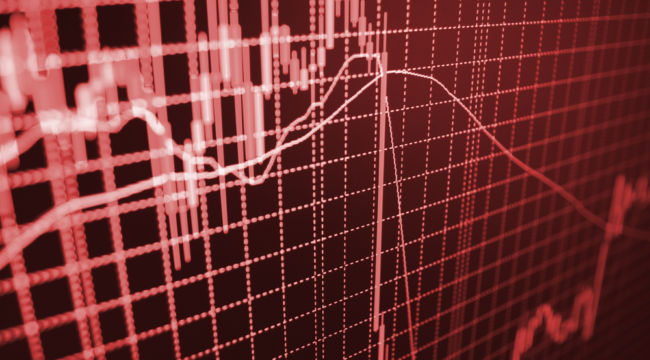Don’t Go Bankrupt With “Buy and Hold”
When I first wrote my best-selling book, An American Hedge Fund, several “financial experts” told me straight up that I was crazy.
They didn’t think average retail investors and traders would understand my niche strategy that, I’ll admit, was definitely not “buy and hold.”
That is the mainstream’s main investment strategy, a strategy that at best earns them 10% a year, maybe 20% in a truly exceptional year.
They tell you to save money for 30, 40 years and let your wealth compound over the decades.
Then you might have a chance of retiring with enough money.
But when you’re in your 30s, 40s and 50s, you’ve got tons of bills to pay, a mortgage, your kids’ tuition, on top of feeding your family, etc.
How are you supposed to give your family the good life you want to provide them while still saving enough for retirement?
The simple fact is that many people cannot.
No wonder one recent survey found that more than half of Americans have less than $10,000 saved for retirement, with one in three having nothing saved. Think about that! How can these people ever retire?
Meanwhile, the average Social Security benefit of about $1,400 is an absolute joke. Good luck paying all your living expenses and medical bills with that pittance.
This is a crisis in the making.
But let’s say you’re approaching retirement and you’ve managed to have a nice nest egg saved up. What if a market crash comes along and wipes out half your wealth practically overnight? It could take at least a decade to make it back. Or you might never be able to make it back at all.
How would you ever be able to retire? And what would happen to all your retirement dreams that you’d worked so hard for?
This Tuesday proved how hard and fast markets can fall. The Dow lost 800 points, its fourth-worst single-day point loss in history. It was down hundreds of points again today before a late rally saved the day — for now.
We’ve seen plenty of days like these in the past couple of months. They seem to be happening far more frequently.
And if you’re a “buy and hold” investor, your investments have probably suffered. After you factor in the past couple months’ losses, the major averages have gone practically nowhere on the year. Nowhere!
What if another round of selling starts? The latest trade war truce could collapse, for example. And that’s just one potential source of market turmoil.
Or even if it doesn’t happen and the stock market recovers from all the recent volatility, what about the next time? We all know there will be a next time.
It’s not a matter of if. It’s just a matter of when. How much more warning do you need?
But when the next stock market crash comes, I’m afraid that most people will be like a deer caught in the headlights.
They’ll lose everything again. And they’ll never have a chance to retire with enough money. I hate to even think about it. But to be candid, if you don’t prepare now, that could be you.
And if you’re just following a buy and hold strategy, you will get caught in the next crash, with 100% certainty.
This strategy greatly reduces your vulnerability to a market crash. It’s like having crash insurance. I know that sounds like a stretch. But properly applied, it’s true. Why?
Because your money’s not tied up in “buy and hold” investments that are highly vulnerable to a crash if you know how to use it. You’re in and out before a crash can erase your wealth.
Look, if you ask me, following traditional financial advice is among the riskiest of things you can do with your money.
Go to any “respected” financial blog, and you’ll quickly see that it makes a couple assumptions…
- It assumes that you can minimize your risk by “diversifying” your portfolio. That is, you can protect yourself by making investments in some mythical combination of stocks, funds, bonds and other securities.
- It assumes that your goal as an investor is to achieve an 8-10% rate of return each year.
Now, this is going to sound crazy to those of you who haven’t known me very long…
But those two assumptions are some of the riskiest things I’ve ever heard of!
Let’s back up a minute, though, and look at what a portfolio that follows these assumptions looks like in real life…
Let’s say you started saving for retirement at 25 years old. You committed to saving 5% of your, let’s say, $55,000 a year income until you reached 65, at which point, you hope you can retire.
Now let’s assume your salary grew a few percent a year and that inflation held between 2–3% (I know, a lot of assumptions here).
Since most retirement calculators assume you’re going to need 85% of your pre-retirement salary each year you’re in retirement, we can safely say that you’re going to need between $2-$3 million dollars in your accounts to cover your post-working expenses.
If you follow the investing model described above, do you know how much you’re going to wind up with?
Not even $850,000.
You aren’t just a little short – you’re millions of dollars off! And that’s something that no amount of diversification is going to fix.
If you follow the conventional wisdom, you’re basically going to be spending your golden years living off cat food and hoping you never need to go to the doctor (let alone undergo something big like a hip replacement or cancer treatment).
I mean, look at the numbers up there!
And that’s discounting that the calculator I used to run those numbers included Social Security benefits.
(I hope I’m not surprising you when I say the Social Security system is pretty much worthless. If you’re counting on it to provide for you when you retire, that’s truly as risky as you can get.)
What else could go wrong with the plan above?
Well, what if there’s another major recession right before you’re supposed to retire, as I discussed earlier?
What if future taxes go higher to cover the country’s deficit, cutting into the amount you’re able to draw from your retirement accounts?
Most of your contributions are tax-deferred, so you’ll be stuck paying whatever rate is in effect when you retire.
I can’t think of anything riskier you could do than to hinge your comfort, your happiness and your enjoyment of your golden years on traditional financial “wisdom!”
That’s why I invite you to join me next Wednesday, Dec. 12 at 1 p.m. EDT, when I sit down with Larry King to address America’s retirement crisis. It’s completely free to attend. Click here to sign up.
Regards,
Tim Sykes
for TheDaily Reckoning



Comments: